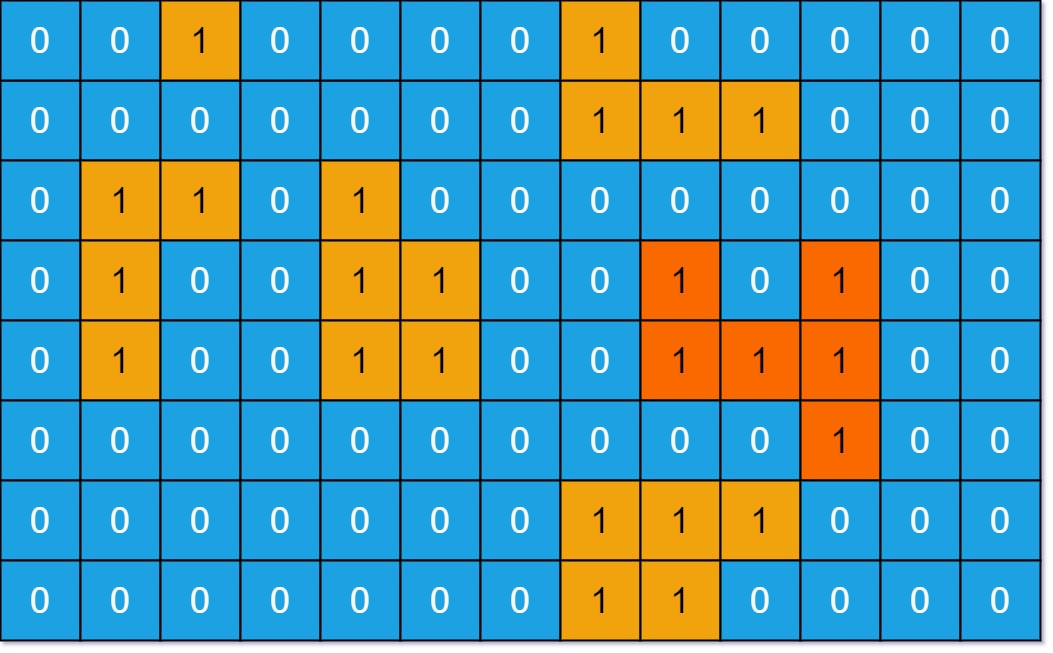You are given an m x n binary matrix grid. An island is a group of 1's (representing land) connected 4-directionally (horizontal or vertical.) You may assume all four edges of the grid are surrounded by water.
The area of an island is the number of cells with a value 1 in the island.
Return the maximum area of an island in grid. If there is no island, return 0.
Example 1:
Input: grid = [[0,0,1,0,0,0,0,1,0,0,0,0,0],[0,0,0,0,0,0,0,1,1,1,0,0,0],[0,1,1,0,1,0,0,0,0,0,0,0,0],[0,1,0,0,1,1,0,0,1,0,1,0,0],[0,1,0,0,1,1,0,0,1,1,1,0,0],[0,0,0,0,0,0,0,0,0,0,1,0,0],[0,0,0,0,0,0,0,1,1,1,0,0,0],[0,0,0,0,0,0,0,1,1,0,0,0,0]]
Output: 6
Explanation: The answer is not 11, because the island must be connected 4-directionally.
Example 2:
Input: grid = [[0,0,0,0,0,0,0,0]]
Output: 0
Constraints:
m == grid.lengthn == grid[i].length1 <= m, n <= 50grid[i][j]is either0or1.
這題與 200. Number of Islands 類似
不同的是這次找出最大的 island 面積,也就是連結 cell 的個數
題目給定一個 m by n 的 0-1 矩陣 grid , 1 代表陸地,0代表海洋
定義水平或垂直方向都是 1 的 cell 是相連的
這些連結的 cell 所形成的群叫作 island
求最大的 island 所包含的 cell 個數
直觀的作法是透過 dfs 來累計 cell 個數
對於 grid 上的每一個值為 1 的 cell 用 dfs 去尋找相連的 cell 並且累計
就是以下個關係式
dfs(row, col) = grid[row][col] + dfs(row-1, col) + dfs(row+1, col) + dfs(row, col - 1) + dfs(row, col+1)
要注意的是已經累加過的cell 不能重複加,所以需要一個 hashset 去做紀錄
package sol
type Pair struct {
row, col int
}
func maxAreaOfIsland(grid [][]int) int {
ROW := len(grid)
COL := len(grid[0])
visit := make(map[Pair]struct{})
var dfs func(row int, col int) int
dfs = func(row int, col int) int {
if row < 0 || row >= ROW || col < 0 || col >= COL ||
grid[row][col] == 0 {
return 0
}
if _, ok := visit[Pair{row: row, col: col}]; ok {
return 0
}
visit[Pair{row: row, col: col}] = struct{}{}
return 1 + dfs(row-1, col) + dfs(row+1, col) + dfs(row, col-1) + dfs(row, col+1)
}
area := 0
for row := 0; row < ROW; row++ {
for col := 0; col < COL; col++ {
total := dfs(row, col)
if total > area {
area = total
}
}
}
return area
}- 理解如何找尋連結的 cell
- Understand how to calculate connected area
- Use HashMap to reduce TimeComplexity

